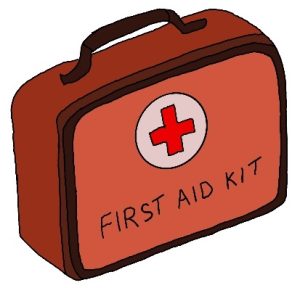A 7.0-magnitude earthquake hit the California coast at 10:44 a.m. Thursday morning. Immediately, tsunami warnings were issued to cell phones around the greater Bay Area and along the coast, spanning from Santa Cruz County to Douglas County, Oregon.
Causing significant unrest, many Paly students and families found themselves worried. For Paly junior Tali Lehrer, this warning was troubling.
“When people started talking about a potential tsunami, I got really scared,” Lehrer said. “Because my sister is farther up north, I was definitely worried that if things got worse, she would be affected.”
In preparation for future earthquakes and in order to create a safer environment for you and your family, this is a guide to making an emergency/earthquake kit, to be ready if a larger-scaled earthquake hits your home.

- Flashlight and batteries
Often, power lines will fall or get hit by trees during an earthquake; power will most likely be cut off by the city to prevent dangerous electrical conditions. According to ABC10, earthquakes of 7.0 magnitude will likely cause power to go out across a region. If an earthquake hits at night, or power doesn’t come back for a while, there will be no way to charge any electronic devices, turn on any lights, cook any food or use any elevators. A flashlight would surely come in handy.

2. Food and water
If your house becomes an unsafe area, your food will be inaccessible. Restaurants will likely be shut down and finding food might become a struggle. Keeping canned food, water, and non-perishables in your kit can help your family after an emergency or disaster. Being properly prepared would entail having enough supplies for multiple days.
 3. First Aid Kit
3. First Aid Kit
In case someone in your family gets injured or hurt, it would be ideal to have a first aid kit inside your emergency/disaster kit. Earthquake County explains that hospitals and first responders could be overwhelmed and unable to provide immediate assistance. Having your own kit could save lives, prevent injuries, or simply reduce some stress.

4. Extra clothing
If you leave your house in pajamas, or if you don’t have time to grab a jacket, having extra warm and comfortable clothes could become pretty important if you are out of the house for several days, or overnight. Extra socks can act as gloves too, and help keep yourself warm. The Red Cross also suggests having rain gear depending on the weather in your area.
 5. Family and emergency contact information
5. Family and emergency contact information
Having copies of important documents such as insurance and emergency contacts can be a game changer. Would you be able to remember your relatives’ phone numbers if your phone died? So much information is solely online. We need to have some physical paper on us in case of an emergency. This information can be put on a piece of paper or journal in your kit.

6. Extra Cash
If you are stranded without your wallet, some extra cash can be of major assistance. If stores can’t take online transactions or the registers aren’t working due to the power being shut off, having some physical money on you can definitely help. The Red Cross highly recommends you include this on your list.
This is just a start to building a kit for your home, car or room. For more information, the Red Cross’ list of Survival Kit Supplies is a great starting point.
Natural disasters are a big part of living in California. We live in an area highly vulnerable to wildfires, earthquakes, and tsunamis. Having a kit ready to go can not only keep you safe, warm, and fed for several days but it can also save your life.












![UNSUNG HEROES — Fred Korematsu, Karen Korematsu and Aiko Herzig-Yoshinaga are awarded the Asian American Justice Medal to recognize their fight for justice following the incarceration of Japanese Americans during World War II. In addition, scientists Shuji Nakamura, David Ho, Tsoo Wang, Mani Menon and Chih-Tang “Tom” Sah receive the Asian American Pioneer Award. "[As a scientist,] it is crucially important to be able to communicate your work and your discoveries to [not only] other scientists, but also to the general public," Ho said. Photo by Talia Boneh](https://cmagazine.org/wp-content/uploads/2025/07/useee-1200x800.jpg)


